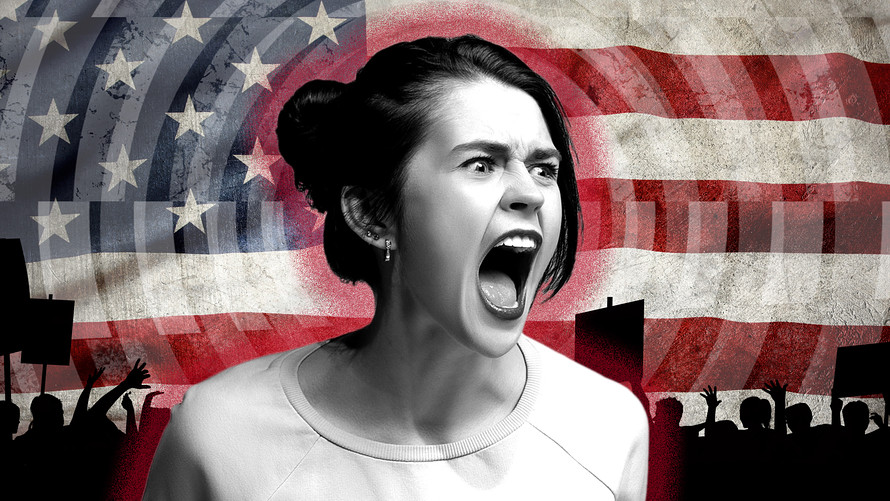
by Moe | Jul 13, 2022 | Neoliberalism, Political Metaphysics, Traditionalism
Several studies on mental and physical health in relation to political ideologies have identified a significant gap between those people on the right, who are often called conservatives, versus the left who are associated with liberals.
Over two decades of supporting research has shown overwhelmingly that left-wingers or liberals tend to more often suffer from mental illness than right-wingers or conservatives.

This may surprise some people, but it shouldn’t because there is a lot of research showing that conservatives tend to be more grounded than liberals. They are less likely to be neurotic or psychotic, healthier, and happier than their counterparts on the left.
Liberalism has been found to be associated with higher levels of neuroticism (anxiety and emotional instability), social desirability, and self-esteem. Conservatives were more likely to be conscientious (high levels of self-discipline), whereas liberals were more likely to be open-minded, curious and creative.
The American Psychiatric Association’s Diagnostic and Statistical Manual of Mental Disorders (DSM) defines psychotic individuals as having “distorted thinking” and “grossly disorganized behavior.” In other words, their thought processes are irrational and disordered.
A person with psychosis may experience delusions (false beliefs) or hallucinations (seeing something that is not there). Psychotic disorders include schizophrenia, bipolar disorder, major depression with psychotic features, schizoaffective disorder and schizophreniform disorder.
According to Pew Research Center survey published in March 2020, white liberals/Democrats are much more likely to have been diagnosed with a mental health condition compared with their moderate and conservatives peers. This poll showed that mental health conditions varied considerably by race, even in the “very liberal” category.
The studie’s author, Zach Goldberg, had published study’s info in a set of visuals and posted them to a thread on Twitter.
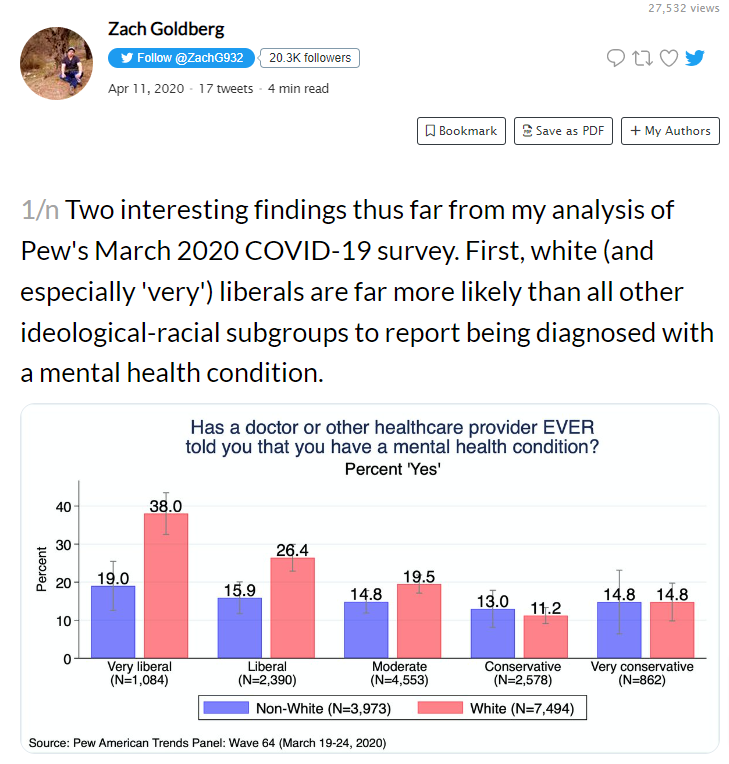
The difference is much more pronounced in the younger female aged category of 18 to 29-year-olds, with the highest percentage at a whopping 56%.
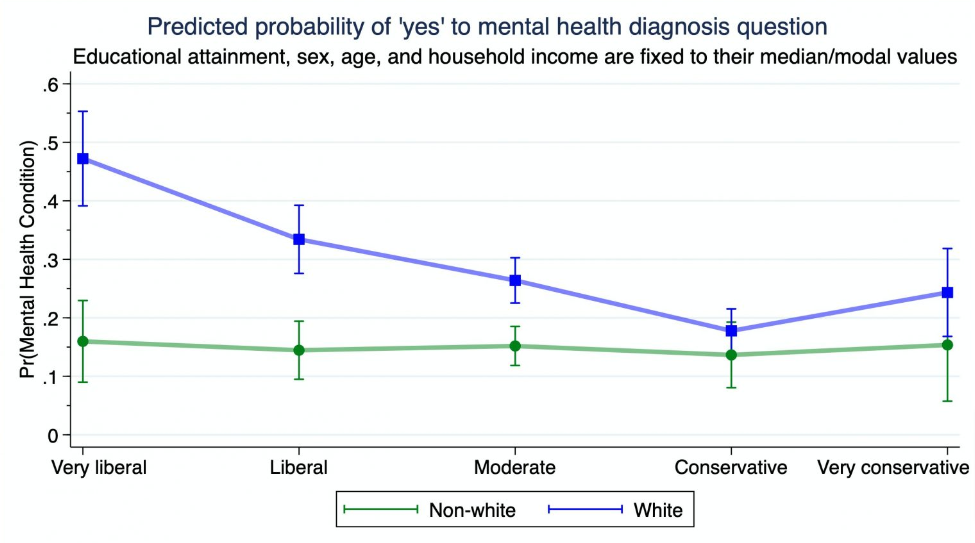
Here is an example of Pew Research statistics of young women diagnosed with a mental condition:
56% of young white liberals
28% of young white moderates
27% of young white conservatives
Here are the statistics of young men diagnosed with a mental condition:
34% of liberal/Democrat men
22% of moderate men
16% of conservative men
A recent study from the University of Pennsylvania found that conservatives were more likely to be happier and satisfied with their lives compared to liberals. The study also found that conservatives were more likely to have higher levels of well-being than liberals.
The study concluded that the difference in well-being was due to political ideology rather than demographics such as income or education level. It also found that this difference was most prominent in younger adults who were still forming their political ideologies.
Another study conducted by Duke University showed that liberals were more likely to experience depression than conservatives, and that they also had higher rates of suicide attempts as well.
Also, political conservatives are happier, healthier, and stronger than liberals. A 2012 study found conservatives score higher than liberals on personality and attitude measures that are traditionally associated with positive adjustment and mental health, including personal agency, positive outlook, transcendent moral beliefs, and generalized beliefs in fairness.
Several studies show conservatives believe more in cultural traditions of a developed society along with individual freedom combined with individual responsibility, a limited government, economic opportunity, strong national defense (and in-group preservation), and belief in a transcendent moral order.
In contrast, liberalism is based upon beliefs in progress, equality, tolerance, and pluralism in matters of morals, religion, and politics, and see government as a vital instrument for solving social injustice (Brooks, 2010; Chambers, Baron, & Inman, 2006; Hunter, 1992; Lakoff, 2002).
A 2019 political psychology study found that people with conservative political attitudes tend to have better physical health than their liberal counterparts (Chan, 2019).
In 2020, a study found that political ideology may also be relevant to mental health, as people who are more liberal, especially those identifying as “extremely liberal,” are more likely to have mental health problems.
The researchers found that these mental health issues on the Left were not just compared to conservatives, but also with those identifying as “liberal” or “slightly liberal.” This tendency for mental illness was more pronounced for people who identified as “extremely liberal,” who were reported to be worse off on several metrics.
However, the study found that those who identified as “extremely conservative” had comparable levels of mental health to those identifying as “conservative” and “slightly conservative.” Conservatives also reported being happier than liberal groups.
Another 2020 study investigated a large pool of adult Americans to see whether there was a relationship between political ideology and mental health. The researchers found a strongly elevated risk for mental illness among the extreme liberals (+150%), a small increase among the liberals and slightly liberals (+29 to 32%), and somewhat lower rates among conservatives and extreme conservatives (-17 to 24%).
Researchers in Brittain found people with clinical symptoms of anxiety disorders tend to express higher concerns about economic inequality and the environment, according to new research published in the International Journal of Psychology. The findings indicate that anxiety symptoms are slightly more common among those with a leftist worldview in Great Britain.
“It’s no wonder that researchers have been interested in the underpinnings of political orientation for so long,” said study author Vilja Helminen (@vilja_h), a doctoral candidate at the University of Helsinki.
“But a lot of the studies have focused on how individuals self-identify on a liberal-conservative continuum. So, we were interested in what goes on behind those labels, how threat sensitivity in the form of anxiety disorder symptoms is related to a wider range of political attitudes.”
Other studies have shown that while both conservatives and liberals experience stress, conservatives are better able to cope with stress than liberals, who tend to become depressed or anxious when facing difficult situations.
GNOSTIC WARRIOR CONCLUSION
It doesn’t take a psychiatrist to understand that some people in American culture suffer from mental illness. In fact, it is very common with nearly one in five U.S. adults living with a mental illness, which equates to 52.9 million people in 2020. This number must be much higher in 2022.
What that means is that when you walk down the street, 1 in 5 people you encounter are mentally ill. Now, we know that these people tend to be attracted to the left and liberalism.
There are several reasons why this may be so:
Conservatives tend to have stronger religious beliefs than liberals do, which gives them a sense of meaning in life and a sense of belonging that helps them cope with difficult situations.
Liberals often lack these things because they reject traditional religious beliefs and lack the support networks provided by church members who help one another through difficult times.
Conservatives are more likely to marry and stay married than leftists are, which provides them with another source of support during difficult times as well as social support for their ideas and beliefs from their spouse or partner. This is particularly true for men since men tend to be more active in politics than women do (although women have been getting more active recently).
I also believe that a major part of this problem is at U.S. universities because it is well-known that academics lean extremely to the left (especially in the softer fields), and show high rates of mental illness (Duarte et al., 2015; Kinman & Wray, 2013; Langbert, 2018).
Studies have also reported higher rates of mental illness among college students and PhD students in particular with a higher suicide rate (Levecque et al., 2017; Puthran et al., 2016; Rotenstein et al., 2016; Twenge et al., 2010).
This would help exacerbate the problem of mental health in younger liberal adults who are being influenced through the education system.
These findings above prove that there is a link between liberal political ideologies and mental health problems.
In recent years, there has been a rise in the number of people identifying themselves as liberals or leftists and also culture wars between the left and the right.
This can be attributed to a number of factors, including the increased acceptance of LGBTQ+ people, women and minorities in society; however, it is also mainly due to a growing prevalence of mental illness among this group and it is only getting worse by the year.
SOURCES:
Barry R. Schlenker a, John R. Chambers a, Bonnie M. Le b (2011) Department of Psychology, University of Florida, Gainesville, Florida, United States Department of Psychology, University of Toronto, Ontario, Canada
Chan, E. Y. (2019). Political orientation and physical health: The role of personal responsibility. Personality and Individual Differences, 141, 117–122. https://doi.org/10.1016/j.paid.2019.01.005
EOW Kirkegaard · 2020 MENTAL ILLNESS AND THE LEFT
Clinical symptoms of anxiety disorders as predictors of political attitudes: A prospective cohort study Vilja Helminen,Marko Elovainio,Markus Jokela First published: 13 August 2021 https://onlinelibrary.wiley.com/doi/full/10.1002/ijop.12796
Other sources listed above or linked to
Moe is the founder of GnosticWarrior.com. He is a father, husband, author, martial arts black belt, and an expert in Gnosticism, the occult, and esotericism.

by Moe | Sep 5, 2021 | Mind Control Research, Political Metaphysics, Propaganda, Traditionalism
This week, China announced that it has just instituted a law banning effeminate men from TV and the internet has part of a National crackdown to protect their culture against these Western neoliberal influences. Communist Party of China’s propaganda department called for “resolutely put an end to sissy men and other abnormal esthetics,” using an insulting slang term for effeminate men — “niang pao,” or, “girlie guns.”

Legal authorities say the effeminate propaganda they are targeting is coming from various TV and music celebrities and also who they call “vulgar internet celebrities.” They rightly claim this creates an unhealthy admiration of wealth and celebrity causing certain distracting activities and will establish a “correct beauty standard,” and boycott vulgar internet celebrities.
The Chinese government is instructing its citizens and especially its TV programmers should avoid performers who “violate public order” or have “lost morality,” and programs about the children of celebrities also are banned. They want Broadcasters to promote “revolutionary culture,” broadening a campaign to tighten control over business and society and enforce official morality, and are calling for programming that “vigorously promote excellent Chinese traditional culture, revolutionary culture, and advanced socialist culture.”
Last week, China regulators reduced children’s access to online games after passing a law allowing only three hours of gaming per week. Rules that took effect Wednesday limit anyone under 18 to three hours per week of online games and prohibit play on school days.
Chinese authorities have accused some people in the entertainment industry of bad influence on the young and of “severely polluting the social atmosphere.” As a result, over the last few years, several celebrities and overtly vocal billionaires have been deleted from the internet as if they never existed and were issued hundred million dollar fines by the Chinese government.
For example, a famous actor and billionaire investor, Vicki Zhao Wei, was scrubbed from the Chinese internet without explanation. A famous actress, Zhao Wei, has disappeared from streaming platforms without reason. Her name has been scrubbed from credits of movies and TV programs as if she was never alive. In 2018, the country’s leading actress Fan Bingbing disappeared for more than two months before reappearing, embarrassed and ready to pay a fine of over $100 million for her tax and contractual indiscretions.
President Xi Jinping’s mission is for a “national rejuvenation,” with tighter Communist Party control of business, education, culture, and religion.
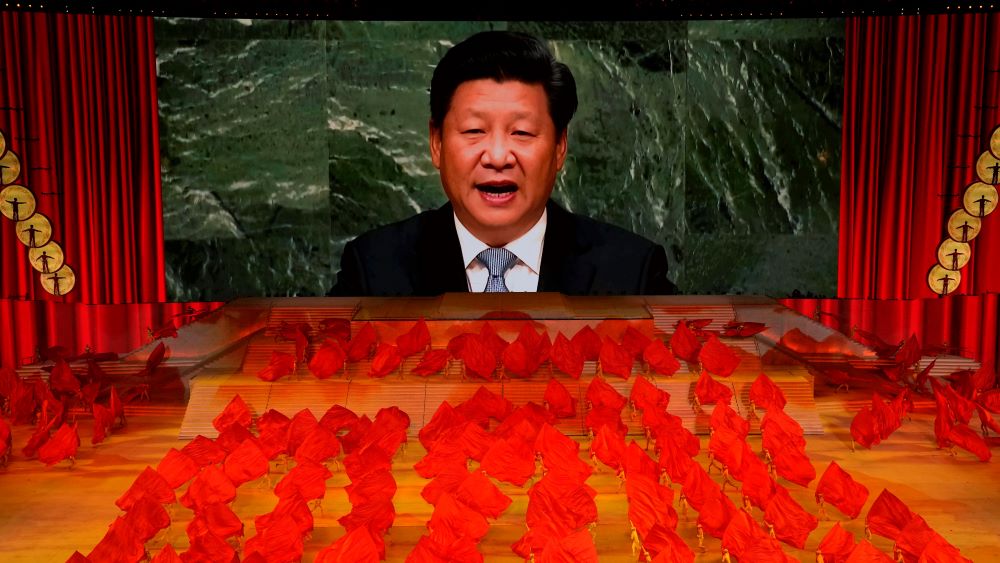
According to a 2015 study, “this “phenomenon of fake women” (weiniangxianxiang) – effeminate men who look more feminine and alluring than real women – sparked indignant discourses chastising it as an epitome of the loss of Chinese manhood and a threat to the nation-state. Experts in China, counselors, and educators called for “saving boys” through revamping the education system and underscoring gender-difference education in schools and families.
The researchers quoted many studied, “Effeminate men, contrary to the ideal entrepreneurial masculinity in postsocialist China, were given the name “fake women” in the media. The expression “fake women” stemmed from roles created in Japanese animation and comic games, where male actors displayed feminine beauty, and after extensive use of make-up, possibly equaled or at times exceeded feminine beauty (Xia 2010). News reports portrayed these effeminate men not only appearing in outlandish, ostentatious clothes, but also harboring feminine personalities” (Ying 2009; Ju 2009; Ony 2007; Ai 2007; D. Qiao 2005).
In other studies, researchers found that “The lack of manhood was repeatedly linked to the crisis of the nation-state.”
“The future of our nation is worrisome with the disappearance of manly heroism and masculine spirit,” as the discourse lamented (Yue 2012). Authors contended that a harmonious nation should have men who behave like men and women who behave like women, otherwise the nation would cease to be harmonious (Zhang 2012).
To save the nation, men’s gender-appropriate code of conduct was underscored and reasserted, the researchers emphasized.
Today, in the West, effeminate celebrities dominate and rule almost every aspect of our TV and internet programming. It is out of control and their egos need to be checked so this news from China’s government tightening control over their celebrity culture and neoliberal Western influences could not make me happier.
In my opinion, America should institute similar laws like China that are more in line with our Traditional Cultural Values of all nations of the West.
Moe is the founder of GnosticWarrior.com. He is a father, husband, author, martial arts black belt, and an expert in Gnosticism, the occult, and esotericism.
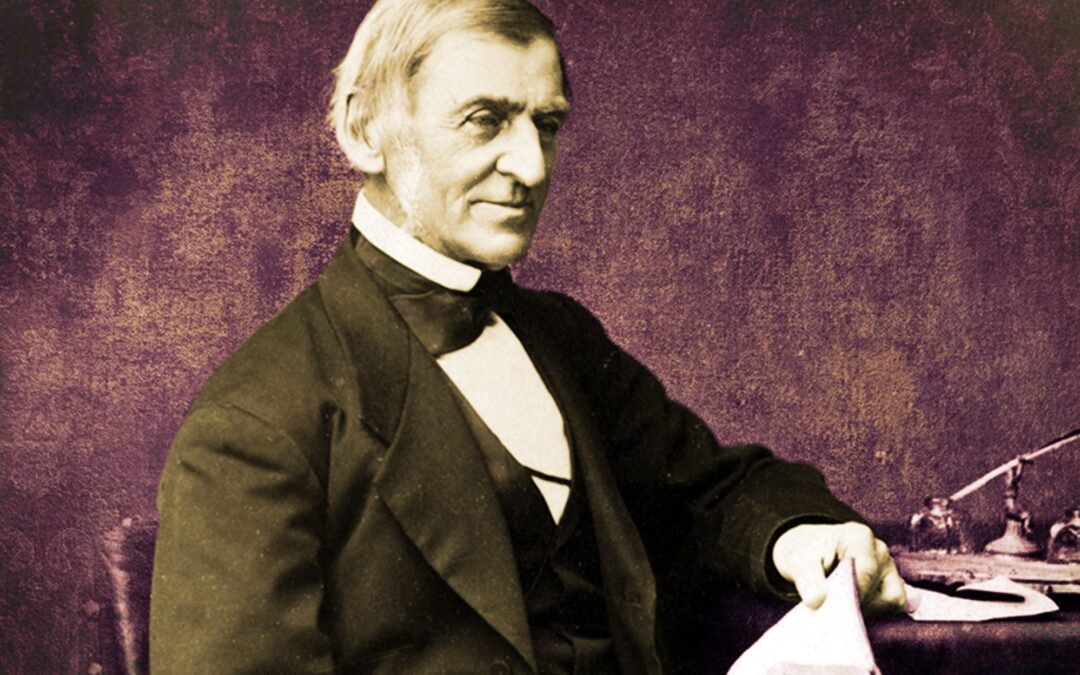
by Moe | Aug 28, 2021 | Freemasonry, History of the Brotherhood, Political Metaphysics, Traditionalism
“I am present at the sowing of the seed of the world.” – Ralph Waldo Emmerson
During his Harvard commencement speech in 1837, Ralph Waldo Emmerson (May 25, 1803 – April 27, 1882) took the podium to address the top students in the graduating class marking the capstone in a week of ceremony and tradition. In his speech, titled “The American Scholar,” Emerson commanded that our young country must develop a national intellectual life distinct from the colonial influences of the past. He condemned the academic scholarship of the time for its reliance on historical and institutional wisdom.
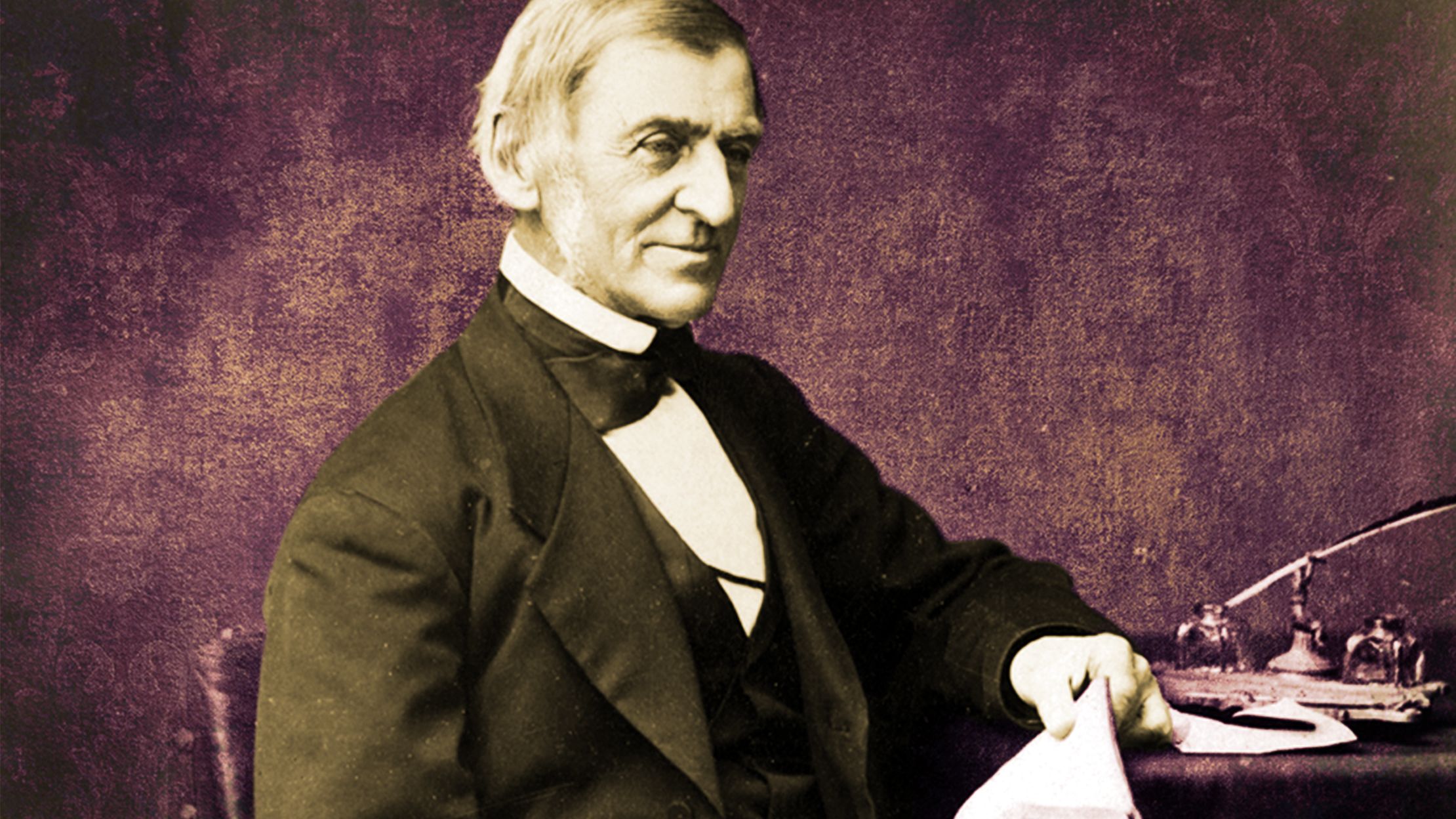
Emmerson argued that the scholar had become “decent, indolent, complaisant.” To become more than “a mere thinker, or, still worse, the parrot of other men’s thinking,” a scholar must begin to engage with the world for oneself.
Emmerson is a famous American author and poet who grew up in Concord, Massachusetts, famously known as the home of both Minutemen and Transcendentalists. A place where “embattled farmers” fired “the shot heard ’round the world,” starting the war for political independence on the 19th of April 1775. The place where I contend that the traditional landscape of Freemasonry and philosophy were officially changed to what was we see today in the West.
Emmerson’s “The American Scholar” would give a new voice to the movement’s individualism: envisioning an independent American intellectual culture premised not on any kind of nationalist pride—nor any particular doctrine or political system—but on a dedication to independence itself. He would later define the “American idea” he sought to promote through his work simply as “Emancipation.”
Emerson’s speech left a particular impression on two members of the Harvard community, a troublemaking undergraduate named James Russell Lowell and a recent alumnus named Oliver Wendell Holmes.
“The Puritan revolt had made us ecclesiastically and the Revolution politically independent, but we were still socially and intellectually moored to English thought,” Lowell later wrote, “till Emerson cut the cable and gave us a chance at the dangers and the glories of blue water.”
Holmes called the speech America’s “intellectual Declaration of Independence.”
The world-famous Freemason and author Emmerson first preached the doctrine of “self-reliance” and Transcendental individualism, which directly conflicted with the tenets of Masonic fraternalism. After all, Freemasonry follows an ancient tradition reaching back to Ancient Egypt, Greece, Rome, and King Solomon’s Temple. Masons are expected to absorb these lessons dictated by our tradition and authority because, since ancient times, local lodges were governed by rules and constitutions tightly regulating the conduct of individuals.
However, Transcendentalists Freemasons like Emmerson urged Americans to free themselves from the dead hand of the past. As Emerson directed in his essay “Nature,” the transcendentalists sought freedom from the “poetry and philosophy of … tradition” and “religion by … history.”
This is where the idea of how to live much more liberally and do not honor our ancient traditions is sown like a seed by Emmerson into the American mind and Freemasonry. The Ancient Charge from the Records of Lodges of FreeMasons had stated their precepts emphatically, “A Mason is obliged by his Tenure, to obey the moral Law; and if he rightly understands the Art, he will never be a stupid Atheist nor an irreligious Libertine.”
Masonic historian and 33rd Degree Freemason Albert Mckay had written that a stupid Atheist is, “the fool who has said in his heart there is no God,” while an “irreligious libertine” designated “the man who, with a degree, less of unbelief, denies the distinctive doctrines of revealed religion.” McKay says that “a stupid Atheist” denoted, to use the language of the Psalmist, “the fool who has said in his heart there is no God,” while an “irreligious libertine” designated the man who, with a degree less of unbelief denies the distinctive doctrines of revealed religion. (Mackey’s Encyclopedia of Freemasonry)
I contend that Emerson’s ideas were also not in line with the original American Founders who believed in progress, enlightenment, and “a new order of the ages” but they also honored the ancient Greek and Roman traditions, philosophies of the religious basis of morals, and common law. Most of the Founders also came from conservative and orthodox (or “right-believing”) Christian religious traditions. For example, in the cases of John Jay, George Washington, Edward Rutledge, John Adams, Samuel Adams, Charles Carroll, and Daniel Carroll, and Thomas Fitzsimmons.
They were all baptized, listed on church rolls, and married to practicing Christians. In public statements, they invoked divine assistance. Many of them were Freemasons.
Robert P. Kraynak, professor of political science at Colgate University in Hamilton, New York, describes them as “enlightened traditionalists. Kraynak writes;
“The American Founders were unusual as eighteenth-century leaders because they were shaped by both the old world of aristocracy and the new world of democracy. They believed in progress, enlightenment, and “a new order of the ages”; but they also revered the ancient Romans, English traditions of the gentleman statesman and common law, the religious basis of morals, and practical experience.”
Kraynak stated, “The fourth element, cultural traditions, extends the idea of moral order to social practices. The American Founders believed that liberty required natural law (an objective standard of justice) and customs, habits, and manners derived from the heritage of Western civilization and English and American history.
I use the phrase “cultural traditions” as a catch-all phrase to refer to the values and beliefs handed down over centuries from several ancient sources—from classical Greek and Roman ideals of republican virtue and patriotic citizen-soldiers; from the English heritage of common law jurisprudence; from the ideal of gentlemen statesmen (possessing the gentleman’s code of honor); from Protestant Christianity and its biblical beliefs about America as a “city on a hill” charged with moral duties, such as the work ethic, the struggle against sin, and charity for the poor; and from the historical experience of local self-government in colonial assemblies and the harsh self-reliance of frontier life.
The implication is that liberty was embedded in cultural traditions that gave it higher and nobler purposes than mere self-expression or the values of a consumer-entertainment society. The American Founders assumed that such customs and traditions would provide a set of moral virtues for the exercise of responsible liberty by citizens and leaders.”
As you can see, Emerson’s demands that people free themselves from the dead hand of the past is not at all in line with the original ethos of the American founders. However, his ideas and influence would spread around America and the world.
Emmerson had many connections through his family and his Masonic membership. He was a member of the Corinthian Lodge, which played an essential role in starting the liberal revolution. He lectured there for many years, finding a very influential audience for his ideas. Quickly, his liberalist doctrines infected other people, lodges, and eventually, I contend, changing the very laws in our court systems to be pro-liberal.
Tracing the lineage from Traditional Freemasonry to Liberal Masonry is crucial to documenting the change. As the Masonic scholar, Robert A. Gross from the University of Connecticut writes;
“Well over 150 men passed through the Corinthian Lodge between 1797 and 1832; spiritual rebels like Thoreau can be counted on two hands. But, even more to the point, Freemasonry was the faith of the Transcendentalists’ fathers. The Rev. Ezra Ripley, member of both the Corinthian Lodge and the Royal Chapter and forceful defender of the fraternity in its time of woe, was the step-grandfather of Emerson.
His generational counterpart was the erstwhile minister and clergyman Asa Dunbar, the maternal grandfather of Thoreau. Tracing the lineage from Freemason to Transcendentalist is indeed as crucial to our intellectual history as following the path from Jonathan Edwards to Ralph Waldo Emerson.”
Emmerson was not only well connected in the states, but he also had some serious connections all over the world. In 1826, faced with poor health, Emerson moved to a warmer client in St. Augustine, Florida, where he took long walks on the beach and began writing poetry.
While in St. Augustine, he made the acquaintance of Prince Achille Murat, the nephew of the former French emperor Napoleon Bonaparte, who had renounced his European titles (after his father had already been overthrown) and immigrated to the United States. Murat was also a writer, and the two young men reportedly discussed religion, politics, and philosophy.
In 1833, Emerson turned his love of writing into a career as a frequent lecturer. He traveled around New England, reading his essays and speaking to audiences about his views on nature, the role of religion, and his travels. In 1838, Emerson was invited to Divinity Hall, Harvard Divinity School, to deliver the school’s graduation address, which came to be known as the “Divinity School Address“.
Emerson discounted biblical miracles and proclaimed that, while Jesus was a great man, he was not God: historical Christianity, he said, had turned Jesus into a “demigod, as the Orientals or the Greeks would describe Osiris or Apollo”.
His comments outraged the establishment and the general Protestant community. He was denounced as an atheist and a poisoner of young men’s minds. Despite the roar of critics, he made no reply, leaving others to put forward a defense. He was not invited back to speak at Harvard for another thirty years.
In 1841 Emerson published Essays, his second book, which included the famous essay “Self-Reliance.” His aunt called it a “strange medley of atheism and false independence,” but it gained favorable reviews in London and Paris. More than any of Emerson’s contributions to date, this book, and its popular reception laid the groundwork for his international fame.
At the time, Emerson made a left turn from his contemporaries’ religious and social beliefs, formulating and expressing the philosophy of transcendentalism in his 1836 essay “Nature“. In 1837, he detailed this new doctrine in a speech entitled “The American Scholar“, which Oliver Wendell Holmes Sr. considered to be America’s “intellectual Declaration of Independence.”
Emerson’s family was well connected to other Liberal transcendentalists such as the family of Henry James Sr. and one of the most famous liberal justices to ever to sit in the U.S. Supreme Court, Oliver Wendell Holmes, who was appointed by President Franklin D. Roosevelt and was generally associated with the liberal wing of the Court on most issues as I will discuss in the next chapter.
Holmes once said that he wanted to be a man of letters like Emerson. While he was a student at Harvard, he had written various papers on philosophy and even an attack on Plato’s idealist philosophy, which he asked Emerson to read. Emerson famously replied, “If you strike at a king, you must kill him.”
In the following decades, until the modern-day, Freemasonry would suffer significantly for abandoning its founding principles based on Ancient Traditions for a more liberal and Transcendentalist Masonry. Rather than honoring tradition, following the idea of Emerson’s famous saying, “an institution” is not merely “the lengthened shadow of one man.”
No longer is a Masonic initiate subject to an extreme examination of his character by a special committee. Once admitted to a lodge, the Mason remained subject to collective discipline for immoral or criminal conduct. It was not about individualism but shared beliefs creating mutual bonds and loyalties to a more significant cause.
The new ethos was of a piece with the individualistic world of Ralph Waldo Emerson and Henry David Thoreau.
Emerson was a well-paid and famous lecturer touring locations across the northern United States and in Canada. He was delivering up to 70-80 lectures a year in his prime, attracting the attention of Herman Melville, who attended his speaking engagements in New York City. In addition, he would go on walks with Nathaniel Hawthorne and captured the attention of leading theologian and intellectual Henry James Sr., father to William and Henry.
Many authors like Wallace Stevens and Robert Frost embraced and incorporated Emerson’s ideas furthering their spread.
In May 1857, he met at the Parker House Hotel in Boston with Francis Henry Underwood, Oliver Holmes Sr., and the poet and fellow Freemason, Henry Wadsworth Longfellow. Together they founded a magazine, The Atlantic Monthly, which was dedicated to advocating abolitionism and promoting new American ideas and voices.
In their words, they sought to advance American writing and the “American idea” “wherever the English tongue is spoken or read”—a reflection of Emerson’s desire for a national intellectual identity that could transcend the country’s institutions and borders.
In this year 2021, we can say they succeeded in spreading their Neo-Liberal ideas globally through their influence, media, and Freemasonry.
Emerson’s seed he had sown in the world well over 100 years ago is now a mighty oak tree.
Moe is the founder of GnosticWarrior.com. He is a father, husband, author, martial arts black belt, and an expert in Gnosticism, the occult, and esotericism.
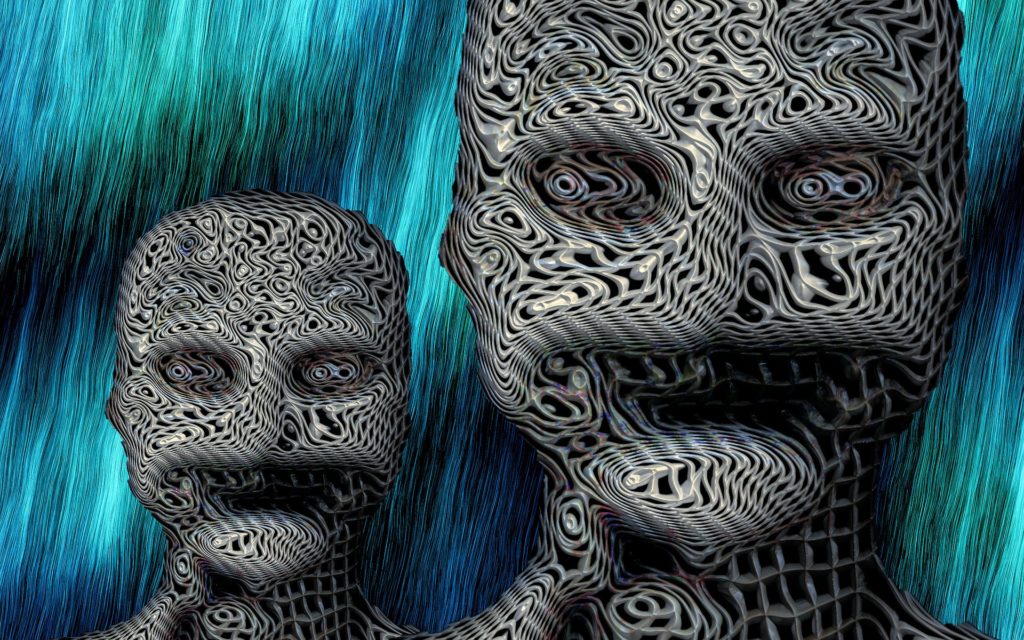
by Moe | Jan 26, 2020 | Latest Media, Political Metaphysics, Science

Much of my work over the last few years has focused on the hidden forces within the human body and from without in which we act as Food for the Moon by these organisms that seek to control, shape, legislate, and if needed be, destroy our modern reality.
As part of my studies into the history of the various political ideologies that have helped “mold our modern era” such as the idea of liberalism in Modernity, I came across some fascinating history connecting the current liberal movement to a much more older form of governing the people that can be found in the Ancient Roman Empire.
You see, in Old Rome, the liberals were the plebians who today are called citizens in the West and would-be followers and worshipers of the god Liber who was a god of viticulture and wine, fertility and freedom. Aspects of the cult were considered very un-Roman and asserted plebeian rights to ecstatic release, self-expression, free speech, and a focus for civil disobedience.
The cult was described to have spread “like a plague” amongst the lower classes, morally weak, effeminate males and anyone who may have leuitas animi (fickle or uneducated minds) but even Rome’s elite were not immune.
Today, among many liberals, we see many of the exact same traits and concepts as if they are taking notes from the old days of Rome. Yes, even our so-called elite in the U.S. like in Hollywood and Washington seem to be internally infected, filamentary connected and unphilosophically driven.
To be honest, it feels like we are now in a global Roman replay on steroids where the lead actors upon the fringe are infecting the entire Culture of the decaying Western world.
My children, your children, and everyone’s children are at stake here to this global Liber virus of leuitas animi.
What is interesting to those people who have an interest in the history, science, and psychology that drives political beliefs whose thought-forms appear to travel into the morphic fields of our nations’ party-centric ideologies is that researchers are starting to discover that there are “psychophysiological stimuli affecting these very political ideologies.”
A recent study claimed that “conservatives react with higher levels of electrodermal activity to threatening stimuli than liberals.”
Meaning, for example, a conservative is more alert and sensitive to parasitism which would make them react and or defend against parasitic attacks.
In the study, the researchers “assessed reliably, electrodermal activity in the replications and published studies captures individual differences in the physiological changes associated with attention shifts, which are unrelated to ideology.
In contrast to psychophysiological reactions, self-reported emotional reactions to threatening stimuli are reliably associated with ideology.”
Here is a summary of the study and a copy of the PDF below.
The Psychophysiology of Political Ideology: Replications, Reanalysis and Recommendations
Going back to the 1950s, studies in both political science and political psychology have proposed that individual differences in political ideology do not just reflect differences in narrow political considerations but, rather, express broader sets of individual differences pertaining to personality, basic values or broader social outlooks (Hibbing et al., 2014; Jost, 2006).
In particular, a common argument has been that a conservative political ideology is likely to be endorsed by individuals motivated to reduce threats in their daily lives. In this view, so-called “threat-sensitive” individuals find the order inherent in a conservative ideology attractive.
A large range of studies support this basic assertion using diverse methods, including assessing differences between liberals and conservatives in self-reported need to reduce insecurity (e.g., Jost et al., 2009), observing the living spaces of liberals and conservatives (e.g., Carney et al., 2008), assessing personality differences between liberals and conservatives (e.g., Gerber et al., 2010) and investigating the impact of threatening events (e.g., terrorist attacks) on public endorsement of conservative policies (e.g., Merolla & Zechmeister, 2009).
While psychologists have turned towards neuroscience in understanding the biological underpinnings of political ideology, political scientists have turned towards techniques from psychophysiology. Whereas measures obtained via neuroscience methods are expensive and require extensive training, psychophysiological studies are far less costly to conduct (Soroka, 2019).
In particular, this work has focused on the measure of skin conductance or electrodermal activity (EDA), an index of sympathetic nervous system arousal obtained by measuring microscopic changes in sweat production via electrodes on the fingertips (Figner & Murphy, 2011). The seminal finding was established by Oxley et al. (2008) who found that conservatives responded with higher EDA than liberals when viewing images of diverse threats such as spiders, maggots and guns.
Since then, a number of follow-up articles have been published, all using psychophysiology to shed light on the psychological underpinnings of political ideology (Dodd et al., 2012; Knoll et al., 2015; Smith et al. 2011).
[pdf-embedder url=”https://www.gnosticwarrior.com/wp-content/uploads/2020/01/The-Psychophysiology-of-Political-Ideology-Osmundsen-et-al-JOP-Preprint-2020-01-14T15_51_59.732Z.pdf” title=”The Psychophysiology of Political Ideology – Osmundsen et al – JOP Preprint-2020-01-14T15_51_59.732Z”]
Moe is the founder of GnosticWarrior.com. He is a father, husband, author, martial arts black belt, and an expert in Gnosticism, the occult, and esotericism.










